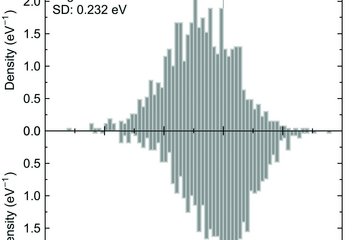All genres
141.
Talk
Catching intermediates of the oxygen reduction reaction in situ: Insights from electrochemical ATIR-IR and DFT. 112th Bunsentagung (Annual German Conference on Physical Chemistry), Karlsruhe Institute of Technology (KIT), Karlsruhe, Germany (2013)
142.
Talk
Probing interfacial layer thickness and electronic properties of electrochemical interfaces: The example of oxide on zinc. 112th Bunsentagung (Annual German Conference on Physical Chemistry), Karlsruhe Institute of Technology (KIT), Karlsruhe, Germany (2013)
143.
Talk
ATR-IR spectroscopic study of H2O and D2O in one-dimensional confinement. 112th Bunsentagung (Annual German Conference on Physical Chemistry), Karlsruhe Institute of Technology (KIT), Karlsruhe, Germany (2013)
144.
Talk
Towards Understanding the Mechanism of the Electrochemical Oxygen Reduction: DFT Modeling and Spectroelectrochemical Validation. Pacific Rim Meeting on Electrochemical and Solid-State Science PRIME 2012 / ECS 222, Honolulu, HI, USA (2012)
145.
Talk
Investigation of electrochemical oxide growth on zinc by spectroscopic ellipsometry: An example of in operando spectroscopy. EMNT 2012 - 9th International Symposium on Electrochemical Micro & Nanosystem Technologies, Linz, Austria (2012)
146.
Talk
Biological D-surface Structure: A Lesson from Nature on Photonic Crystals Design. 10th International Symposium on Photonic and Electromagnetic Crystal Structures(PECS-X), Santa Fe, NM, USA (2012)
147.
Talk
Native and electrochemically grown oxides on metals: The dark side of semiconductor research. Seminar Talk at NTH School for Contacts in Nanosystems Spring Workshop 2012, Goslar, Germany (2012)
148.
Talk
Thin Film Metrology. Seminar "Thin Film Metrology" (together with SENTECH Instruments), MPIE, Düsseldorf, Germany (2012)
149.
Talk
Oberflächendesign für empfindliche ATR-Spektroskopie in Modellexperimenten zum Verständnis der Korrosion. Bruker Optik Anwendertreffen, Ettlingen, Germany (2011)
150.
Talk
Oberflächendesign für empfindliche ATR-Spektroskopie in Modellexperimenten zum Verständnis der Korrosion. Bruker Optik Anwendertreffen, Ettlingen, Germany (2011)
151.
Talk
The three-dimensional photonic crystal in scales of the weevil Entimus imperialis: A natural D-surface bicontinuous structure. Geometry of Interfaces, Primošten, Croatia (2011)
152.
Talk
Structure/function relations of a diamond-based photonic crystal structure in scales of the weevil Entimus imperialis (Curculionidae). Euromat 2011, Montpellier, France (2011)
153.
Talk
In-situ ellipsometric monitoring of electrochemical preparation of ZnO nanoplates. 62nd Annual Meeting of the International Society of Electrochemistry, Niigata, Japan (2011)
154.
Talk
In situ Electrochemical ATR-IR Investigation of the Oxygen Reduction on Germanium. 62nd Annual Meeting of the International Society of Electrochemistry, Niigata, Japan (2011)
155.
Talk
Optical surface design for sensitive internal reflection infrared spectroscopy and applications to electrochemical questions. Seminar, Université de Fribourg, Department of Physics, Fribourg, Switzerland (2011)
156.
Talk
Structure and function of the biological photonic crystals in the scales of a beetle. European Materials Research Society E-MRS Spring Meeting 2011, May 2011, Nice, France (2011)
157.
Talk
Thin amorphous oxides and intermediates in chemical reactions: Challenging problems in interface science probed with photons. Mini-Workshop on Surface Science for Inauguration of the Turkish Surface Science Society, Ankara, Turkey (2011)
158.
Talk
From electrochemistry to colloidal interfaces - optical answers to chemical questions. Seminar, Bilkent University, Department of Chemistry, Ankara, Turkey, (2011)
159.
Talk
Optical design of interfaces for internal reflection infrared-spectroscopic experiments. Seminar, Karlsruhe Institute of Technology, Institute of Toxicology and Genetics. Karlsruhe, Germany (2011)
160.
Talk
Simulation of surface enhanced infrared absorption spectra (SEIRAS). 4th Annual Meeting Photonic Devices, Berlin, Germany (2011)











